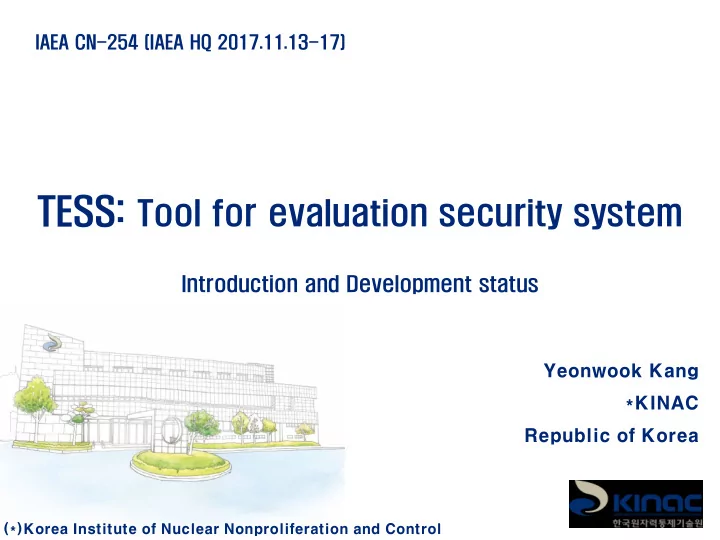

IAEA CN-254 (IAEA HQ 2017.11.13-17) TESS: Tool for evaluation security system Introduction and Development status Yeonwook Kang *KINAC Republic of Korea (*)Korea Institute of Nuclear Nonproliferation and Control
Contents 01 Background 02 Program development strategy 03 Main concepts 04 Algorithm 05 Implementation results
Background ■ Status of evaluating PPS vulnerability - [IAEA INFCIRC/225/REV.5] - [US 10 CFR PART 73.55] Licensee evaluates PPS performance and regulatory body to review it ■ Status of evaluating PPS vulnerability (R.O.K) - [*APPRE/Article16/Requirement for protection of nuclear facilities] Regularly evaluate PP regulation and reflect the results - [APPRE/Proposal] Licensee evaluates PPS performance and regulatory body to review it Detailed scope and method of evaluation Expectation of linkage with VA program (*)Act on measures for the protection of nuclear facilities, prevention of radiation disasters
Background ■ Why we need a VA program [Virtual world: VA program] [Real world: force on force] Force on Force VA program Remark Manpower Need a lot Relatively low military, police, adversary, etc. Budget Need a lot Relatively low Manpower equal to budget Time Need a lot Relatively low More than a week (include preparation) Reality Relatively good - FOF is also constrained by safety reasons Usability Only for training Regulatory purpose Regulatory examination, facility inspection
Program development strategy (1) ■ Benchmark of latest commercial programs (AVERT) VA was conducted through AVERT for two NPP from 2015 to 2017 To be implemented for all regulated nuclear facilities by 2019
Program development strategy (2) ■ Requirement for regulatory VA program Reg Regula latory pro program req requir irements Assumptions should be set conservatively rather than Con Conse servativ ive licensee. Experience using AVERT The result of program should always be same. Determin Det inis istic ic (Compare with monte carlo method) Ac Accuracy Must be proved that route that is searched is weakest. Experience in regulating nuclear facilities Cl Clar arit ity The algorithm used should be easy and understandable. Impl plement Able to implement the same condition as simulator of IAEA NUSAM Project licensee. Same co Sa condit itio ion (2013~2017) Results Data should be based on experiments and logical reasoning, Reali Rea lity of of da data not by the manufacturer. Eas ase of of an analy lysi sis Evaluate vulnerability versus protection requirements.
Main concepts (1) ■ Critical detection point (Timely detection) Task Begin CDP CDP sensors Complete Action Adversary Task Time Adversary Task Time remaining after First Alarm PPS Response Time First Alarm Assessed Alarm Interrupted Adversary Time Remaining Detection Response After Time Force Time Interruption T 0 T I T T Time C A Vulnerable path is minimum detection path before CDP, and minimum time path thereafter
Main concepts (2) ■ 3D GUI Applied (view, move, installation, etc.) ■ 2D Mesh based Algorithm (Apply after 3D data projection) Object data projection to 2D mesh Install building and PPS (CCTV, sensor, guard) 2D mesh has detection and delay data
Algorithm ■ Dijkstra algorithm - [Path finding] Collect data nearby A A: Start point B: Target If small value is found, updated chose smallest one ■ Priority Queue(Min heap) - [cost evaluation: detection rate and delay] Always return minimum data Maximum efficiency with Dijkstra
Implementation results (1) ■ TESS - Overview EDIT Mode EVALUATION Mode Build a physical Evaluation of physical Build a nuclear facility protection system protection system
Implementation results (2) ■ EDIT Mode • Response • Adversary
Implementation results (3) ■ Evaluation Mode - CDP calculation : From target to outside until <RFT = delay time> - Path Finding : From CDP to outside <minimum detection probability> - Neutralization : Using BATTELLE code from U.S DOE - Result : P E and time after interruption CDP CDP CDP CDP RFT = 50s RFT = 100s CDP depends on RFT and delay elements
Implementation results (4) ■ Demo video
Implementation results (5) ■ Upgrade plan (detection and delay)
Future plans ■ Application of large-scale nuclear facilities (2017~2019) ■ Algorithm improvements (2017~2019) FEN WALL TAR OFF GATE DOR Path pattern Adaptive mesh
Recommend
More recommend